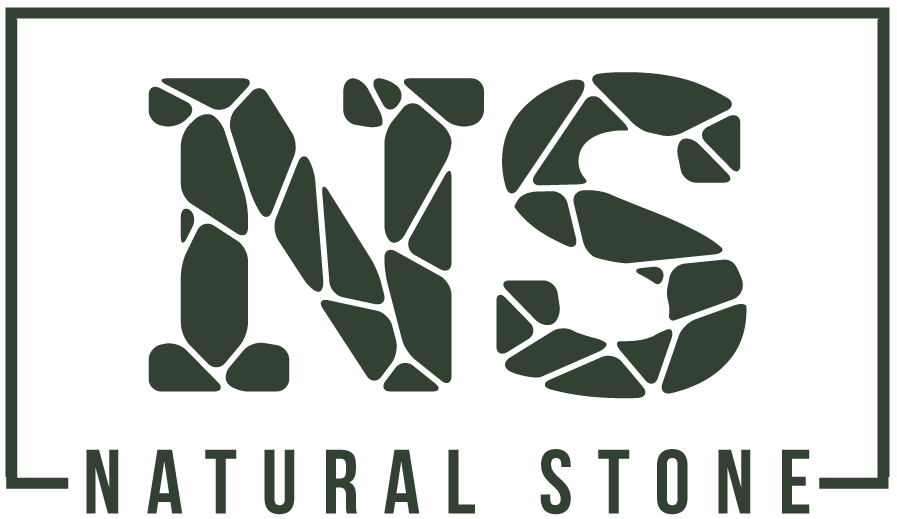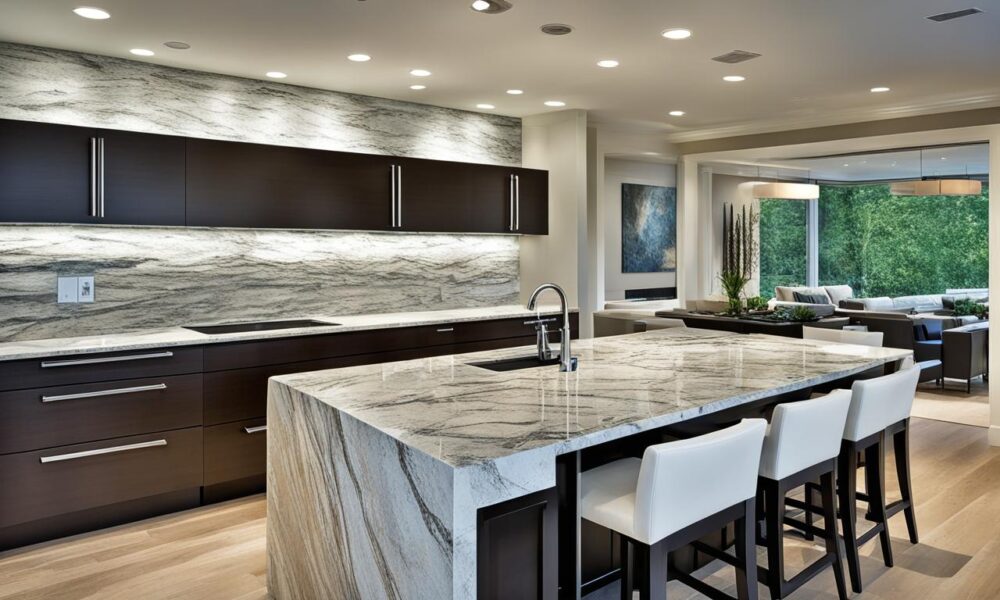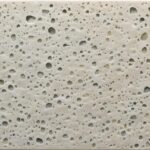Natural Stone Types: Your Guide to Elegant Surfaces
The Earth’s crust is rich with types of natural stone, which have been central in design and architecture through time. Many natural stone options exist today, offering durability and unmatched beauty for homes and businesses. Each natural stone variety, like marble and slate, brings a unique feel. They are popular natural stones for enriching any space.
Natural stone for building adds class, whether to a luxe lobby or a cozy kitchen. With advancements, using these materials has become a link between tradition and innovation. It shows how old practices meet new technology.
Key Takeaways
- Understand the rich variety and the intended use of different natural stone types.
- Explore why natural stone varieties are continuously popular in building and design.
- Learn how natural stone options can elevate the ambiance of any space.
- Discover the historical significance and contemporary utility of natural stone for building.
- Recognize the enduring appeal and versatility of popular natural stones.
Exploring the Beauty and Diversity of Natural Stone Materials
Starting a journey into different natural stones, we discover an incredible variety. These stones are not just beautiful but also very strong. They tell stories of the earth’s history, making them perfect for homes and buildings alike.
The range of types of stone for building is vast. From the robust granite born of fire to the peaceful limestone and sandstone, each carries unique colors. Then there’s marble and slate, transformed under great heat and pressure, offering timeless beauty.
- Granite: An igneous rock beloved for its toughness, making it an excellent choice for countertops.
- Limestone: A sedimentary option known for its earthy tones and used predominantly in flooring.
- Marble: Renowned for its veining and metamorphic elegance, marble is synonymous with luxury surfaces.
- Slate: Its fine-grained texture and durability make it a preferred choice for outdoor and wet areas.
The beauty of these natural stone types is in their uniqueness. No two stones are the same. This unique feature is driving their popularity in the market. Experts predict a growth to $57.6 billion by 2032. They’re chosen for adding elegance to hotels and charm to homes, wrapping spaces in nature’s story.
Marble: The Epitome of Luxury in Natural Stone Options
Marble is known for its beauty and timeless elegance. It’s a top choice among natural stones. With its beautiful veins and colors, it adds luxury to any space. You can find it in many designs, from Carrara’s calm whites to Nero Marquina’s bold contrast.
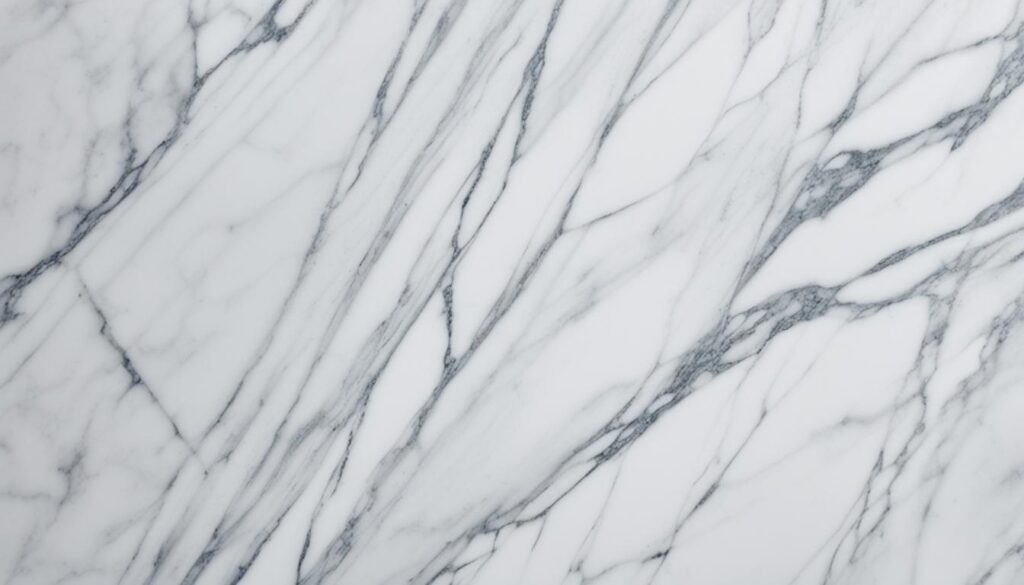
Classical Elegance of Carrara Marble
Carrara marble comes from Tuscany, Italy. It’s famous for its beautiful white look and subtle gray veins. This stone is perfect for those who love timeless style. It’s often used in art and construction because of its light, refined appearance.
Dramatic Presence of Nero Marquina
Nero Marquina marble has a dark background with white veins. It comes from Spain’s Basque Country. This type of marble makes any room stand out. It’s perfect for making a statement, whether as a countertop or an accent piece.
Caring for Marble: Maintenance and Sealing
Marble needs careful maintenance to stay beautiful. Since it’s porous, it can stain or etch easily. It’s important to seal it regularly. To keep its beauty, use special cleaning products that won’t harm it.
| Marble Variety | Origin | Color | Veining | Use Cases |
|---|---|---|---|---|
| Carrara Marble | Tuscany, Italy | White | Soft, grayish | Flooring, Wall Cladding, Sculptures |
| Nero Marquina | Basque Country, Spain | Black | Bold, white | Countertops, Accent Pieces, Flooring |
Natural Stone Types for Lasting Durability: Granite Surfaces
Granite is one of the most durable types of natural stone. It’s key for both home and commercial uses. Known for its strength, this popular natural stone suits areas needing long life and less care. Granite is used for countertops, backsplashes, and floors. It offers practical benefits and adds beauty to any space.
Granite’s wide color range and patterns fit many design styles. It can be the centerpiece of a modern kitchen or match a rustic bathroom. Its unique natural variations make every piece one-of-a-kind. This delights those looking for special, individual spaces.
- Scratch and Heat Resistance: Its hard surface resists scratches and can handle hot items, perfect for kitchens.
- Variety in Aesthetics: With patterns from subtle to vivid, granite adds unique character.
- Low Maintenance: It needs just occasional sealing, making cleaning easier.
Granite’s reliability keeps natural stone materials like these popular in design. Combining types of natural stone with new techniques expands granite’s uses. Architects and homeowners choose granite for its beauty, toughness, and timeless charm.
Incorporating Unique Textures with Slate and Travertine
Homeowners and designers often look worldwide for unique stone for building. Slate and travertine have unique textures that enhance construction or renovation aesthetics.
Rustic Allure of Slate in Design
Slate is a durable, fine-grained rock known for its rustic beauty. Its varying textures and earthy tones are perfect for a natural look. Flooring, roof tiles, and landscaping benefit from its strength and slip resistance.
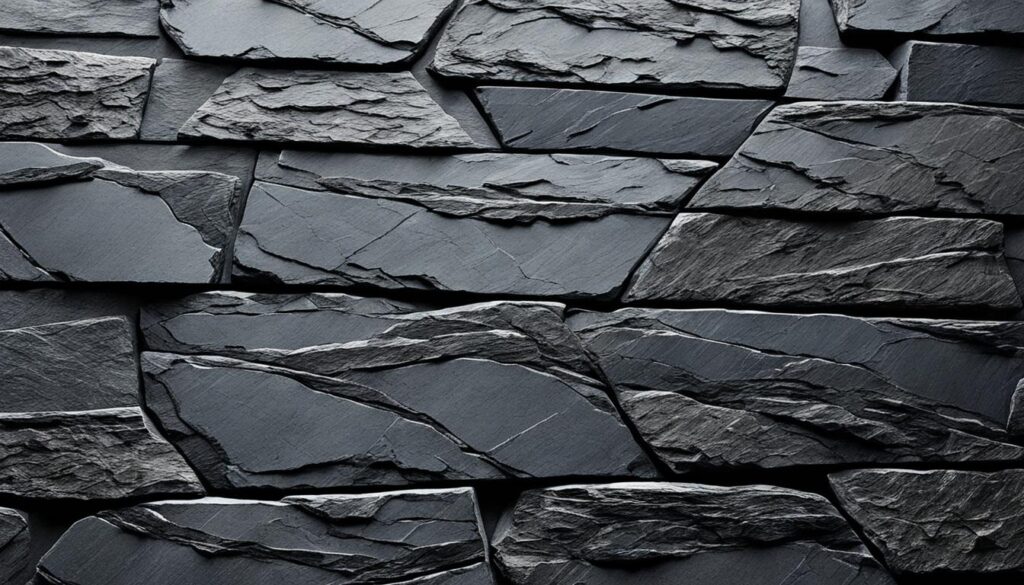
Warm and Inviting Travertine Applications
Travertine is known for its unique pitted surface and warm colors. This makes it great for bathroom floors, cladding, and facades. Although porous, sealing it helps prevent damage, making travertine versatile and valuable.
Choosing the right natural stone involves understanding its visual and functional benefits. Whether it’s slate’s rugged charm or travertine’s warm tones, each stone brings nature’s beauty into your space.
Limestone and Onyx: Understated Elegance and Translucent Beauty
When looking at different natural stones, limestone stands out. It catches the eye of architects and designers. Known for its muted colors and soft textures, it adds a subtle elegance. It’s perfect for floors, wall cladding, and countertops. Its matte finish brings a calm sophistication to luxury bathrooms and high-end living spaces.
Onyx, on the other hand, is striking. It’s a natural stone variety that shines with vibrant colors. It’s a show-stopper in any room. When backlit, onyx’s beauty deepens, radiating a magical glow. It makes luxury spaces more stunning. But it needs careful handling and regular upkeep to stay shiny.
It’s interesting to see how natural stone varieties, limestone and onyx, bring their own beauty. They’re both perfect for making spaces unique. They cater to different tastes and styles, each with its own kind of elegance.
| Stone Variety | Visual Characteristics | Common Uses | Maintenance Required |
|---|---|---|---|
| Limestone | Muted hues, subtle textures | Flooring, wall cladding, vanity tops | Regular sealing, gentle cleaning |
| Onyx | Translucent, vibrant colors | Backlit wall features, countertops, artistic installations | Delicate handling, periodic polishing |
While limestone offers peace, onyx makes a bold statement. Both add luxury to design in their way.
The Role of Technological Innovation: Proliner in Professional Natural Stone Installation
The demand for custom natural stone installations is growing. Here, tools like the Proliner play a crucial role. They help fit stones perfectly in our homes and offices. Different stones, like tough granite or soft marble, need careful handling to show their true beauty.
Ensuring Precision with Digital Templating
Installing natural stone has gotten better with digital templating. The Proliner is a top example, giving precise measurements that old methods miss. It’s perfect for complex projects like granite countertops or limestone floors. With the Proliner, every detail is right, making the stone look good and last longer.
Complex Vein Matching for Aesthetic Harmony
Finding beauty in stone veins is both art and science. The Proliner helps match these veins beautifully. It’s key for stones like marble and onyx. It maps the stone’s patterns so everything looks great. This blend of nature and technology turns each project into a work of art.
